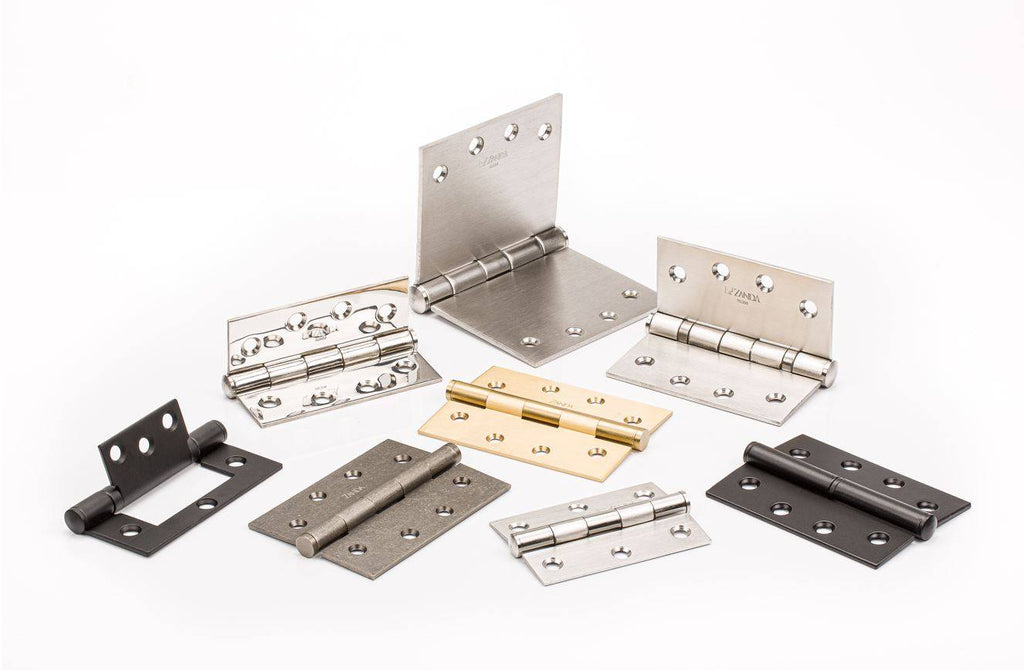No Products in the Cart
CONTACT OUR FRIENDLY STAFF FOR ENQUIRIES VIA PHONE 1300 265 812 OR LIVE CHAT

Door hinges may seem like a small, unimportant part of our daily lives, but they hold a door in its frame, enabling it to function seamlessly. From the most common hinges to their unique counterparts, this blog will guide you through the different types of door hinges, giving you the insights you need to choose the perfect hinge for your needs.
Before delving into the vast array of hinge types, let's recap what a hinge is. A hinge is a mechanical bearing that connects two solid objects, typically allowing only a limited angle of rotation between them.
Among the most common hinges, the butt hinge is a classic choice for interior doors. Known for its two leaf hinges that meet when the door is in the closed position, the butt hinge is the backbone of many doors in homes and businesses alike.
The ball bearing hinge is a type of hinge with a central pin holding ball bearings that reduce friction, making it an excellent choice for heavy doors and high-traffic doors. They are often used on entry doors, as they provide a smooth and stable operation even under heavy use.
For a sleek, modern look, concealed hinges are your go-to option. Hidden from view when the door is closed, concealed hinges, as the name suggests, blend into the door frame for a clean aesthetic. These are popular choices for cabinet doors, offering an unobtrusive look while maintaining functionality.
Featuring a long, decorative arm that's visible when the door is closed, strap hinges lend a rustic charm to your doors. Often crafted from solid brass or steel, these hinges are a favourite for barn doors or other outdoor applications where style is just as important as function.
Pivot hinges offer unique functionality, installed at the top and bottom of a door, with a pivot point that enables the door to swing in both directions. These are commonly called pivot hinges, and they are a go-to for heavier doors, given their robust construction and load-bearing capabilities.
Continuous hinges, also known as piano hinges, run the entire length of the door, providing increased stability and support. Whether on a piano lid or heavy-duty doors, continuous hinges ensure an even distribution of weight along the hinge, making them ideal for load-bearing applications.
Overlay hinges are a sub-type of concealed hinges, used predominantly on cabinet doors. They allow the door to overlay the cabinet's face, and their adjustable nature helps to perfectly align doors, ensuring a clean finish.
The rising butt hinge is a unique hinge type designed for situations where a door needs to self-close or rise slightly when opened to clear an uneven floor. This makes it an ideal hinge for exterior doors where weather and wear might result in uneven surfaces.
This is merely scratching the surface of door hinge types. From offset hinges, designed to allow a door to swing clear of the door frame, to barrel hinges that offer a low profile and lay flush with the surface, the choices are virtually limitless.
Spring-loaded hinges, such as the spring-loaded butt hinge, are ideal for doors that require automatic closing, while butterfly hinges are named for their decorative shape, often found on jewellery boxes or light furniture lids.
For doors needing to open 180 degrees, like storage boxes or cabinets, pivot hinges, often pivot-hinged doors, are the solution. Similarly, heavy-duty hinges are made for just that—heavy-duty use. These are typically found on exterior door hinges, where durability is paramount.
Flush hinges, another type of concealed hinge, are commonly used for lighter doors, where the door material may not support a heavier hinge. They offer the benefit of not requiring a recess to be cut, making installation a breeze.
Lastly, for a classic look, look no further than European hinges. These are a type of concealed hinge often used on cabinet doors, where they offer a clean, contemporary look and allow for easy adjustments to align doors perfectly.
Choosing the right type of door hinge might seem trivial, but it's vital for the functionality, durability, and aesthetics of your doors. With this guide in hand, you're now well-equipped to navigate the seemingly complex world of door hinges, from butt hinges to the intricacies of offset hinges and stylishly concealed European hinges.
Remember, a door hinge is not just a piece of hardware; it's a vital component that ensures your door operates smoothly and aligns perfectly within its frame. Whether you're refurbishing a vintage house, creating a modern office space, or simply curious about door hinges, remember this: every door tells a story, and the hinge is an essential part of that tale.
From the humble butt hinge to the robust continuous hinge, the world of door hinges is as diverse as it is fascinating. So, the next time you walk through a door, take a moment to appreciate the door hinge that makes it possible and marvel at the seamless blend of engineering and design.
That's all for this deep dive into the types of door hinges. Whether for your front door, interior doors, or a cabinet in the corner of your living room, always remember: it's not just about aesthetics—it's about function and durability, too. Keep those doors swinging!